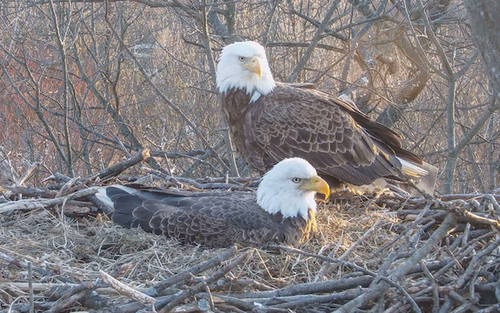Hanover Bald Eagle Blog # 7 - 2020
In partnership with Pennsylvania Game Commission and Comcast Business .
Today is the 46th day since the Hanover egg was laid. Unfortunately, your speculations are correct: at this point, the nest has failed. The “hatch window” for bald eagles is between 34 and 38 days, with 35 days being the average. There have been rare accounts of eggs hatching later, however I could not find any mention of eggs hatching past 44 days.
Watching these hard-working parents incubate in vain was an understandably difficult scene to observe. That being said, failed nests are a relatively frequent occurrence within the raptor world, and even highly experienced parents have bad years. For large eagles in particular, successful fledging of 2-3 young is not a consistent outcome.
There are several potential reasons why this year’s egg did not hatch
1.The chick was unable to break out of the shell
2.Incomplete fertilization
3.Embryonic death
Sometimes a fully developed chick will struggle to emerge from the egg, either because it is too weak, oriented downward at hatch time, or too large to properly maneuver through a small opening. The size of a chick can be impacted by humidity levels; high humidity increases the rate of water loss within the egg resulting in a smaller, weaker individual. In this case, we did not see clear signs of emergence such as a crack or a pip in the eggshell, implying that incomplete fertilization or embryonic death are the most likely causes of this year’s nest failure.
Incomplete fertilization may have occurred if Liberty’s ovum was not fertilized by Freedom’s sperm at the right time, either due to poorly timed copulations, low sperm count, or poor-quality sperm.
Embryonic death could have taken place at any stage in development. A potential reason for this outcome would be insufficient gas and water exchange between the inside and outside of the egg. The composition of the eggshell must be the right thickness to allow gas exchange, yet simultaneously prevent bacteria from entering the inside of the egg. If there was an imbalance in these structural components, growth may have failed. As development progresses, the eggshell naturally becomes thinner as the chick absorbs some of the calcium into its bones, and consequently the egg becomes more delicate and susceptible to breakage. Although Liberty and Freedom were noticeably careful around the egg, jostling may have occurred without notice and if an opening was created, bacteria may have entered. Other potential causes of embryonic death could have been insufficient nutritional health of the mother, issues with rolling the egg, or inadequate incubation resulting in a poor growth rate for the embryo. As we all know, Liberty and Freedom are experienced incubators and rarely left the egg. Therefore, whatever happened was likely internally derived.
Bald eagles do not have pocket calendars, nor do they keep note of when the hatch window has closed. Rather, they are attuned to signs that the chick is beginning to emerge from the egg. If these cues do not occur, a pair’s natural inclination is to continue incubating. Liberty and Freedom have already recognized (in their own eagle way) that the egg was non-viable, hence Liberty’s consumption of the egg’s contents. Although a mother eating her own egg may seem quizzical to us, few wild animals can afford to pass up a nutritious meal regardless of its origin. At this point both Liberty and Freedom know they will not be raising offspring this year, and ensuring their own health is the next task.
At this point, Liberty and Freedom may hang around the nest for 1-3 weeks, depending on their movement strategy. If they are migratory individuals, they may leave early. If they plan on sticking around all year, then the nest may continue to function as a roost or feeding site for a while. Eventually, we should see them depart the nesting area.

RETURN TO HANOVER BALD EAGLE BLOGS
WATCH THE HANOVER BALD EAGLE LIVE CAMS
For over 20 years, HDOnTap has provided live streaming solutions to resorts, amusement parks, wildlife refuges and more. In addition to maintaining a network of over 400 live webcams, HDOnTap specializes in design and installation of remote, off-grid and otherwise challenging live streaming solutions. Contact press@hdontap.com for all media needs, including images and recordings.